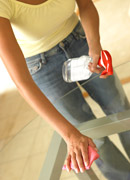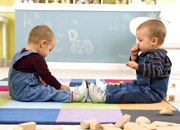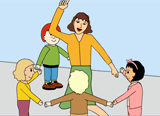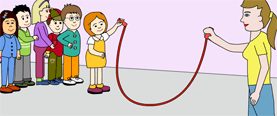Behaviour
Caring for babies
Bottle feeding
Changing a nappy
Cleaning and sterilising bottles
Daily cleaning tasks
Helping new children settle in
Preparing for a nappy change
Sleep patterns – babies
Sleep routines – babies
Toilet training
Caring for children
Allowing time for practice
Dressing/undressing
Mealtimes
Nappy change
Packing away/caring for the environment
Sleep/rest time
Toileting
Common self-help milestones
Tips for sleep and rest time
Self image
Communication
Body language
Limits and guidelines
Ways children communicate
Greeting children and families
Modelling appropriate communication
Questioning
Verbal and non–verbal communication
Acknowledging children's feelings
Listening attentively
Communicating with Aboriginal and Torres Strait Islander parents/carers
Development
Allowing time for practice
Dressing/undressing
Mealtimes
Nappy change
Packing away/caring for the environment
Sleep/rest time
Toileting
Common self-help milestones
Creative development
Language development
Modelling positive relationships
Physical development
Sharing and taking turns
Sleep patterns – babies
Sleep routines – babies
Encourage independent problem solving
Fundamental movement skills
Health, hygiene and safety
Coping with stress
Correct manual handling principles
Daily cleaning tasks
Hand washing
Hand washing poster
Manual handling overview
Toilet training
Safety checklist
Learning experiences and play
Environmentally friendly learning experiences
Learning experiences for different development areas
Creative resource materials
Arranging the environment to facilitate learning and pleasure
Indoors and outdoor areas
Creating a positive physical environment
Legal and ethical issues
Child abuse case studies
How do I recognise when a child or young person is at risk?
Tips on dealing with disclosures
Observation methods
Arranging Experiences (PDF 351Kb)
Recording observations
Rules for making observations
What you can learn from observations
Programming
Children’s interests, strengths, needs and skills
Extending the children’s interest in dinosaurs
Objective observation
Planning an OSHC environment
Behavior management plan
Planning enjoyable experiences
Planning experiences for 0 - 2 years age group
Planning experiences for 2 - 3 years age group
Planning experiences for 3 - 5 years age group
Planning enjoyable experiences
Thinking ahead
Being prepared and organised is the pivotal part of successfully providing a responsive, interesting and appropriate program for the children you work with.
The program involves the whole day for the children, and this would include:
- routine care experiences
- transitions from inside to outdoors
- play experiences.

Always make sure the experiences and the learning environment are set up in advance, whether this is indoors or outside.
By thinking ahead you will identify any cleaning materials you may need when you pack the experience away - for example, a cloth, warm soapy water, a spatula or a container to clean finger paint off the table and floor.
Remember the five P's of thinking ahead:
Prior Planning Prevents Poor Performance
Number of children to be involved
The younger the child, the fewer the number of children involved in the experience being offered. Below is a suggestion on appropriate numbers for activities with children of three different age groups.

For children less than 3 years of age, an experience needs to be set up for no more than 1 or 2 children at a time.
 For children 3 – 5 years, a maximum of 4 children should participate.
For children 3 – 5 years, a maximum of 4 children should participate.
 For 5 – 12 year olds, no more than 6 children should participate at a time unless it is a sporting game, but preferably no more than 4 children at a time.
For 5 – 12 year olds, no more than 6 children should participate at a time unless it is a sporting game, but preferably no more than 4 children at a time.
Keeping an eye on the numbers can help to reduce the need for children to share and compete for the materials being offered. This helps to reduce or even eliminate conflict.
Remember that younger children are less likely to have developed the skills and understanding involved in taking turns, waiting and sharing. The younger the child, the more duplicates will need to be available. If you have ten toddlers, they need ten bikes!
If the children are really enjoying participating in the block area, you may need to provide two block areas to avoid having too many children in one play space. This may also apply to cubby houses, water play or to any new experience that lots of children find attractive and want to try. For example, if you are washing dolls in a water trough with one or two children and others want to be involved, consider putting water in small trays with containers for pouring. This will disperse the group and avoid the problems that arise when too many children are in the same space.
Click on the correct answer to the question below.